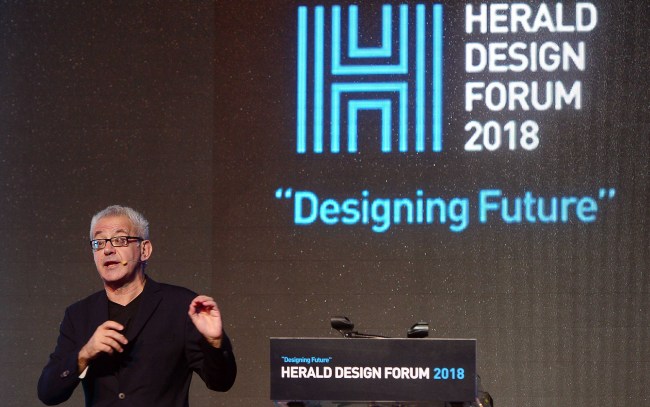[Herald Design Forum 2018] MMCA director Bartomeu Mari says museums will relate more to design
By Shim Woo-hyunPublished : Sept. 15, 2018 - 13:14
Bartomeu Mari, director of the National Museum of Modern and Contemporary Art, Korea, says areas of fine arts will crossover into the areas of design and architecture.
During his lecture at the second day of Herald Design Forum 2018, held at Dongdaemun Design Plaza in Seoul, Saturday, Mari said design had expanded its boundaries and broken the monopoly that fine arts had occupied for a long time.
During his lecture at the second day of Herald Design Forum 2018, held at Dongdaemun Design Plaza in Seoul, Saturday, Mari said design had expanded its boundaries and broken the monopoly that fine arts had occupied for a long time.

The museum space will be inclined more and more towards design and architecture, when preparing exhibitions, Mari pointed out. To make the museum space more physically interactive, museums will make more extensive uses of architecture and design.
“In the future, museums will become places where people actually do things. There will be more physical interactions. The museum audience will no longer remain passive agents, who come and see the objects in the gallery space,” Mari said. “Museums are places not only to enjoy but also to think.”
The future role of fine arts and design is not a conclusive one, he added.
“We need to keep thinking and debating about everything that surrounds us, as well as the ways in which we live within it,” Mari said.
Mari also introduced MMCA’s four branches, mainly their historical and geographical backgrounds.
“In my opinion, Korea has a great opportunity to tell another story of art that is unique,” said Mari when asked how Korean art can appeal to art scenes outside the country, explaining that Korea‘s traditional craft works, for example, carry a unique quality of Korean art. According to Mari, traditional crafts in Korea have a function, theoretically, but that they are not necessarily used for that function. Their main function is the pleasure of visual contemplation of them, like art, Mari said.
By Shim Woo-hyun (ws@heraldcorp.com)


![[AtoZ into Korean mind] Humor in Korea: Navigating the line between what's funny and not](http://res.heraldm.com/phpwas/restmb_idxmake.php?idx=644&simg=/content/image/2024/04/22/20240422050642_0.jpg&u=)
![[Exclusive] Korean military set to ban iPhones over 'security' concerns](http://res.heraldm.com/phpwas/restmb_idxmake.php?idx=644&simg=/content/image/2024/04/23/20240423050599_0.jpg&u=20240423183955)



![[Graphic News] 77% of young Koreans still financially dependent](http://res.heraldm.com/phpwas/restmb_idxmake.php?idx=644&simg=/content/image/2024/04/22/20240422050762_0.gif&u=)
![[Herald Interview] Why Toss invited hackers to penetrate its system](http://res.heraldm.com/phpwas/restmb_idxmake.php?idx=644&simg=/content/image/2024/04/22/20240422050569_0.jpg&u=20240422150649)






![[Exclusive] Korean military to ban iPhones over security issues](http://res.heraldm.com/phpwas/restmb_idxmake.php?idx=652&simg=/content/image/2024/04/23/20240423050599_0.jpg&u=20240423183955)



![[Today’s K-pop] Ateez confirms US tour details](http://res.heraldm.com/phpwas/restmb_idxmake.php?idx=642&simg=/content/image/2024/04/23/20240423050700_0.jpg&u=)